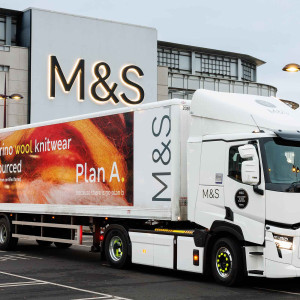M&S Adds 85 Low-Emission HGVs to Its Supply Chain Fleet


Marks & Spencer (M&S) has taken a significant step towards achieving its Net Zero ambitions by adding 85 lower-emission vehicles to its logistics fleet. This includes five zero-emission battery electric HGVs and 80 compressed natural gas (CNG) vehicles, all part of the retailer's Plan A roadmap to achieve Net Zero by 2040. These additions mean almost 10% of M&S's total transport fleet will soon rely on zero or lower-emission technologies.
Zero-Emission Battery Electric HGVs
M&S has introduced five 42-tonne battery electric HGVs to its Clothing & Home logistics operations.
These trucks, manufactured by Renault, will replace equivalent diesel vehicles and service routes between the Welham Green distribution centre and 30 stores across London and the South East, including flagship sites like Oxford Street and Bluewater. These vehicles are part of the eFREIGHT 2030 initiative, a government-backed project under the Zero Emission HGV and Infrastructure Demonstrator Programme (ZEHID). This scheme aims to decarbonise road freight by promoting zero-emission heavy goods vehicles and the infrastructure to support them.
As a founding member of the eFREIGHT 2030 project, M&S will gather operational insights from these trucks to guide future investments in cleaner transport technologies.
Compressed Natural Gas Vehicles
Complementing its electric HGVs, M&S has begun deploying 30 new 6x2 CNG vehicles for its Clothing & Home business, the first UK retailer to adopt this technology. These trucks, developed in collaboration with IVECO, have undergone extensive trials to validate their reliability and environmental credentials. Additionally, M&S has added 50 4x2 CNG trucks to its Food logistics division, operated by Gist.
These vehicles are powered by biomethane, a renewable fuel derived from waste products such as food, animal manure, and wastewater. This fuel reduces CO2 emissions by up to 85% compared to traditional diesel engines, offering a sustainable alternative for the retailer's supply chain operations.
A Broader Commitment to Sustainability
The integration of these 85 vehicles reflects M&S's broader commitment to sustainability through its Plan A roadmap. The retailer continues to explore innovative projects to cut carbon emissions, including trials to produce green hydrogen using wind and solar-powered electrolysis.
Julian Bailey, M&S Head of Group Transport, emphasised the importance of collaboration in reducing emissions: "Adapting our logistics network is vital in achieving our Plan A Net Zero ambitions. We're committed to reducing carbon emissions from our transport and through collaboration we are able to reduce carbon, save energy, and drive operational efficiencies across the business. By trialling new vehicle technologies, we're able to deliver our products, which are sourced and made with care, to our depots and stores with a lower impact on our planet."
Government Support for Cleaner Transport
The UK Government's backing of the eFREIGHT 2030 programme plays a crucial role in this transition.
Lilian Greenwood, Future of Roads Minister, praised M&S's initiative: "We're working with business to lead the charge towards innovative zero-emission vehicles.
That's why it's fantastic to see M&S add five zero-emission electric lorries to their fleet thanks to our GBP200 million to roll out large zero-emission trucks - the biggest investment of this kind in the world.
This comes on top of our GBP2.3 billion boost to help industry and consumers switch to electric vehicles, harnessing the transition to net zero by supporting jobs, attracting investment, and making Britain a clean energy superpower."
More Information:
For more like this, visit the Trucking Magazine website, or subscribe to Trucking Magazine here